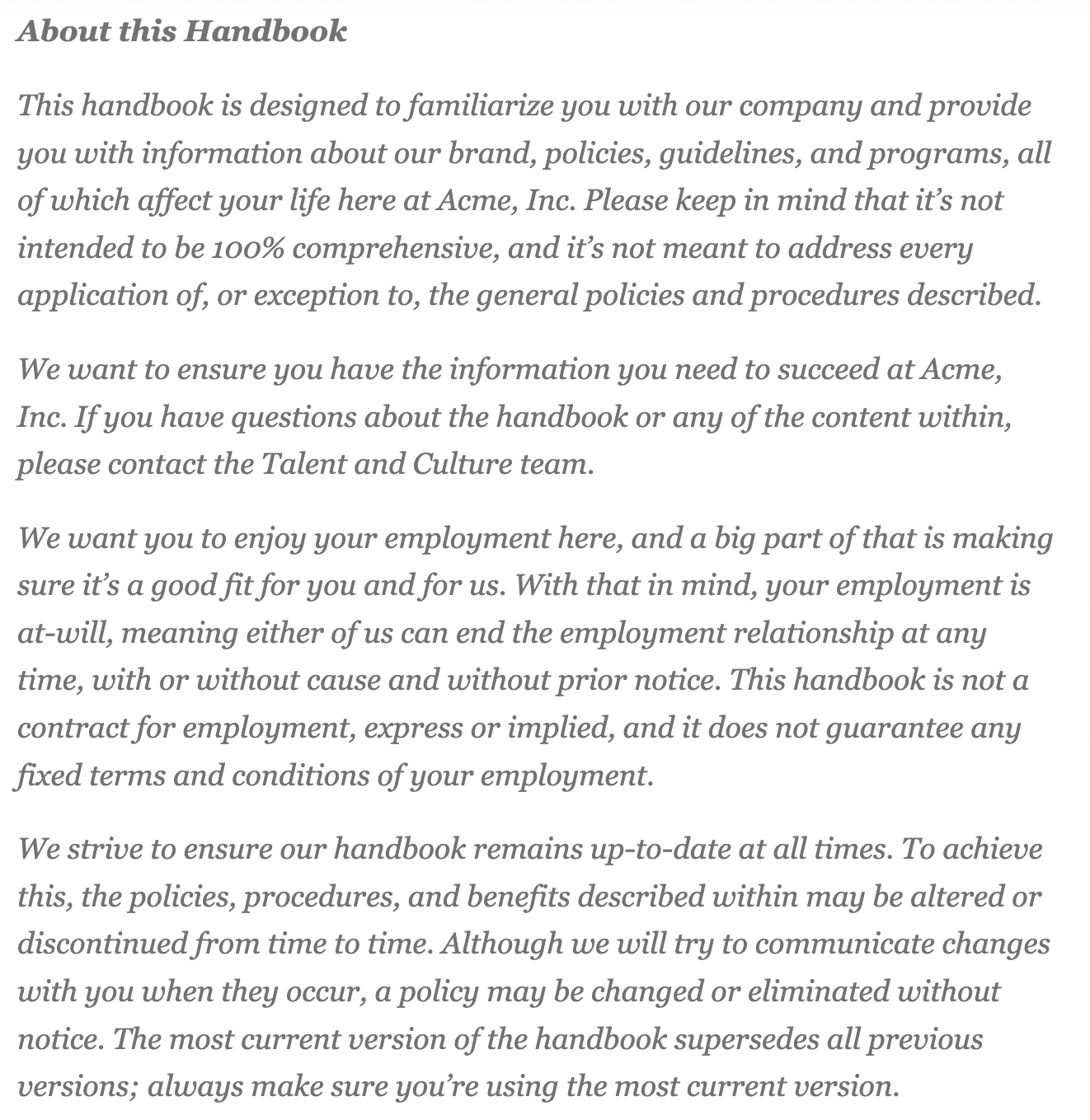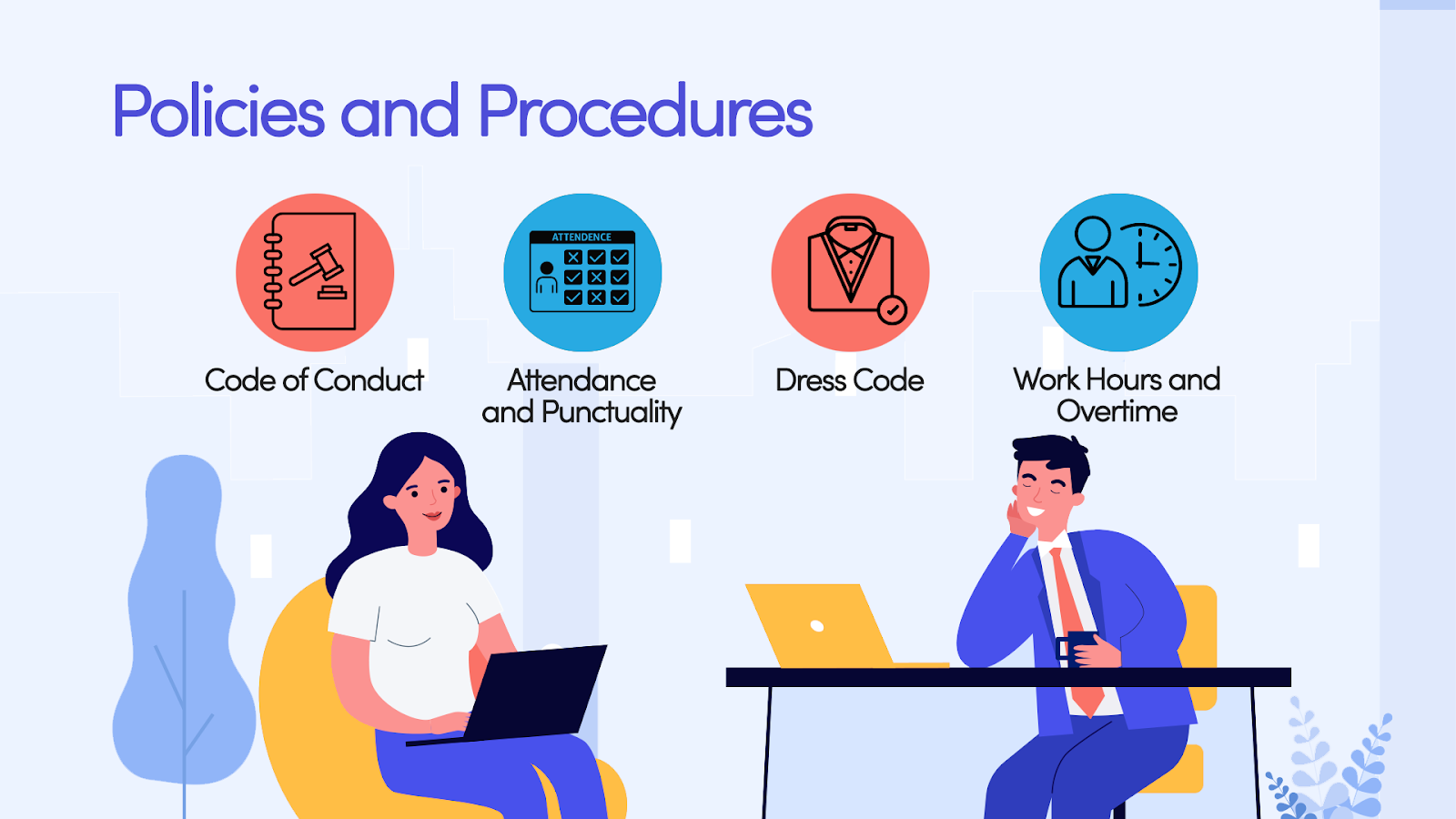Employee Handbook vs. Employment Contract: Differences
In any workplace, knowing the differences between an employee handbook and an employment contract is important. These documents play key roles in defining the relationship between employers and employees, but they serve different purposes and are used in different ways. This article aims to explain these differences clearly. We will look at what each document means, what it includes, and how it impacts both employers and employees. By understanding these distinctions, everyone involved can ensure they are better informed and can make the most out of their roles within the company.
What is an Employee Handbook?
An employee handbook is a document that businesses use to communicate important information about their workplace policies and practices. It usually includes a wide range of topics such as company values, workplace expectations, and employee rights.
Purpose and General Contents
The main purpose of an employee handbook is to outline the company’s policies and procedures. This includes details on attendance, dress codes, benefits, and discipline procedures. It also covers safety guidelines, use of company property, and anti-discrimination policies. By providing this information, the handbook helps ensure that all employees have a clear understanding of what is expected of them and what they can expect from the company.
How it is Used in the Workplace
In the workplace, the employee handbook serves as a reference tool for both staff and management. Employees use it to understand their rights and responsibilities, and to learn about the resources available to them. Managers use the handbook as a guide to enforce policies fairly and consistently. It also helps new employees get up to speed quickly and integrates them into the company culture. Overall, an employee handbook helps create a more informed, organized, and harmonious workplace.

What is an Employment Contract?
An employment contract is a formal agreement that specifies the terms of the relationship between an employer and an employee. Unlike the broader employee handbook, an employment contract is tailored specifically to the individual employee and includes detailed information about their job role.

Purpose and Specific Elements Included
The primary purpose of an employment contract is to clearly define the terms of employment, ensuring both the employer and the employee understand their obligations and the specifics of the employment arrangement. This contract typically includes the job description, salary or wage details, work hours, and terms regarding confidentiality and termination. It may also outline benefits such as health insurance, retirement plans, and vacation time. Employment contracts are crucial for setting clear expectations and responsibilities for both parties.
Legal Binding Nature
Employment contracts are legally binding. This means that once both the employer and the employee sign the document, they are legally obliged to adhere to its terms. This legal nature ensures that both parties can rely on the contract to enforce their rights and responsibilities. If either party fails to meet their obligations under the contract, they can be held accountable in a court of law.
Key Differences Between the Employee Handbook and Employment Contract
While both employee handbooks and employment contracts are fundamental to managing workplace expectations and responsibilities, they serve distinct purposes and have different legal standings. Understanding these differences is vital for both employers and employees to navigate their roles and rights effectively. Let’s explore the major differences, starting with their legal binding status.
Legally Binding Status
Employee Handbooks
Unlike employment contracts, employee handbooks are generally not legally binding. They are meant to be informational guides providing an overview of company policies and procedures. However, there are exceptions where certain policies or statements within a handbook could be considered binding if they are implied as contractual promises. Therefore, it’s crucial for employers to carefully word their handbooks to avoid creating unintentional contractual obligations.
Adding a Disclaimer
One important measure is including a clear disclaimer. This highlights that the handbook serves as an informational guide and not a binding employment contract, preventing employees from misunderstanding its contents as guaranteed employment terms. This clarification protects the company from potential legal challenges and expenses.
To avoid the handbook suggesting it is an employment contract, it is crucial to state in the disclaimer that the employee handbook is not an explicit or implicit employment contract and that employment is not assured for any specific duration.
Below is an example of our own disclaimer:

You may even want to include similar language in your acknowledgement statement or signature page.
Employment Contracts
These are formal agreements that are legally binding. When both the employer and the employee sign an employment contract, they agree to adhere to its terms. This legal enforceability means that if one party does not fulfill their obligations as outlined in the contract, the other party can pursue legal remedies.
Contents and Scope
Employee Handbooks
Employee handbooks have a broader scope and are less detailed regarding individual roles. Instead, they provide a comprehensive overview of company policies that apply to all employees. This includes general workplace rules, company values, procedures for requesting time off, codes of conduct, and guidelines on the use of company resources. Handbooks are intended to be a resource for all employees to understand the general working environment and expectations within the company.

Employment Contracts
In contrast, the content of an employment contract is highly specific and tailored to the individual employee. It includes detailed terms specific to that employee’s role, such as job responsibilities, salary, bonuses, benefits, and the conditions under which the employment may be terminated. These contracts are designed to cover all aspects of the employment relationship between the employer and the specific employee.
Flexibility and Amendment Process
Employee Handbooks
Employee handbooks are far more flexible. Employers can update or amend the handbook at any time as the need arises, such as when there are changes in company policy, laws and regulations, or shifts in corporate culture. These updates do not typically require employee consent, although it is common practice to notify employees of significant changes. This unilateral ability to amend helps ensure that the handbook evolves in step with the company and remains a relevant and useful resource for all staff.
Employment Contracts
On the other hand, these documents are negotiated between an employer and an employee at the start of their employment relationship, resulting in terms that are specifically agreed upon by both parties. Due to this negotiated nature, employment contracts are generally less flexible. Any amendments to the contract require mutual agreement and often necessitate formal renegotiations. This can make changing terms in an employment contract a more rigid and time-consuming process.
Purpose and Function
Employee Handbooks
Employee handbooks serve a broader strategic purpose. They are designed to communicate the organization’s policies, culture, and values to all employees. This document functions as a guide for expected behavior and helps standardize procedures across the company, which is essential for maintaining consistency and fairness in handling workplace issues. Handbooks play a significant role in shaping the organizational environment and influencing employee behavior on a wide scale. They also act as a protective measure for the company, providing a reference that can support the organization in legal or disciplinary matters.
Employment Contracts
The primary strategic purpose of an employment contract, in contrast, is to establish clear, binding terms between an individual employee and the employer. This document is crucial in defining specific job roles, responsibilities, compensation, and the conditions under which the employment relationship can be altered or terminated. Employment contracts serve to protect both the employer’s and the employee’s interests by ensuring there is a mutual understanding and agreement on all critical aspects of the job. By setting precise expectations and obligations, these contracts directly influence an employee’s behavior and performance in their specific role.
The Role of Each in Employee Management
Employee Handbook
Employee handbooks are essential tools for management and staff alike. They serve as the go-to reference for the company’s policies, expectations, and culture, helping ensure that all employees understand what is expected of them within the workplace. This clear communication aids in maintaining a consistent approach to daily operations and employee relations. Furthermore, employee handbooks can be crucial in legal defenses for the company. They document that employees have been informed of company policies and procedures, which can be pivotal in resolving disputes and defending the company’s actions in legal challenges.
Employment Contract
Employment contracts play a critical role in defining the specific terms of employment for individual employees. These contracts make clear the details of the job role, including duties, remuneration, benefits, and the conditions under which employment may be terminated. By setting these terms clearly, employment contracts help prevent misunderstandings and provide a clear basis for evaluating employee performance. They are also crucial in ensuring that both the employer and the employee have a mutual understanding and agreement on the specifics of the job, which can lead to more stable and predictable employment relationships.
Common Misconceptions and Legal Missteps
One common misconception is that employee handbooks are as enforceable as employment contracts. While contracts are binding agreements, handbooks generally are not, except in instances where a policy might imply a contractual promise. On the other hand, some employees and employers may underestimate the significance of the employment contract, treating it as a mere formality rather than a legally binding agreement that dictates the terms of employment comprehensively.
Failing to differentiate clearly between the terms in employee handbooks and employment contracts can also lead to significant legal challenges. For employers, misrepresenting a handbook as a contract can lead to unintended contractual obligations, where employees may claim rights based on what they believed were promises in the handbook. Conversely, if employment contracts are not comprehensive or clear, or if they contradict policies outlined in handbooks, this can lead to disputes that may result in legal action. For example, if a contract states one termination policy but the handbook another, and an employee is terminated, the conflicting information can complicate legal proceedings and potentially result in unfavorable outcomes for the employer.
Best Practices for Employers
Create Clear, Comprehensive, and Compliant Documents
To avoid confusion and legal issues, it is crucial for employers to invest time in creating documents with a few guidelines in mind. This makes documents that are not only clear and comprehensive but also compliant with all applicable laws. When drafting an employee handbook or an employment contract, make sure to:
- Use Simple, Direct Language
Avoid legal jargon or overly technical terms that might confuse employees. Clear language helps ensure that all parties understand the terms and policies.
- Be Detailed and Specific
Clearly outline the responsibilities, benefits, and policies associated with employment. Specify the scope of policies in the handbook and the exact terms in the contract.
- Ensure Legal Compliance
Regularly review and update documents to reflect current labor laws and regulations. This may require consulting with legal professionals to avoid any compliance issues.
Maintain Consistency Between Documents
Consistency between an employee handbook and employment contracts is key to managing expectations and avoiding conflicts. Employers should:
- Align Policies and Terms
Ensure that the general policies described in the employee handbook are not contradicted by the specific terms laid out in employment contracts.
- Regular Updates
Whenever there is a change in company policy or employment law, update both documents to reflect these changes. This helps in maintaining consistency and preventing legal discrepancies.
- Communicate Changes Effectively
When updates are made, communicate these changes clearly to all employees. Consider requiring a sign-off on the revised documents to confirm that employees acknowledge and understand the new terms.
Final Thoughts
We’ve explored the critical differences between employee handbooks and employment contracts, highlighting their unique roles within an organization. Remember, while employment contracts are legally binding and tailored to individual employees, detailing specific job roles and employment terms, employee handbooks provide a broader overview of company policies applicable to all employees, serving as a general guide but typically not legally enforceable.
Both employers and employees benefit greatly from being well-informed about these documents. Understanding the purpose, scope, and legal implications of handbooks and contracts ensures smoother workplace operations and helps prevent potential legal disputes.
For businesses looking to create, review, or update their workplace documents, Blissbook offers a streamlined solution. Using Blissbook to manage your employee handbooks ensures they are up-to-date, clear, and compliant with the latest regulations. This not only helps in maintaining a transparent and consistent policy environment but also in enhancing overall workplace culture. Try out Blissbook today—request a demo and enjoy a free trial to see how it can benefit your organization.